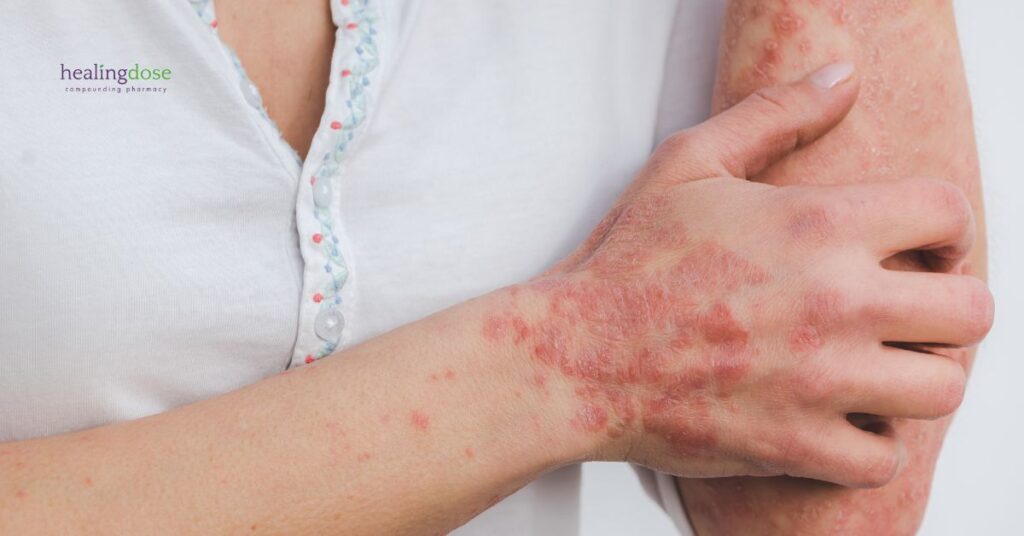Quinacrine for Dermatological Lupus: A Compounded Option Worth Discussing
The Lupus Foundation of America estimates that 1.5 million Americans, and at least five million people worldwide, have a form of lupus.”
Source: Lupus Foundation
When we think of lupus, we often picture joint pain, fatigue, and systemic inflammation. But for many patients, lupus shows up first — and sometimes most prominently — on the skin. Red, scaly rashes. Photosensitivity that makes sunlight feel like an enemy. Discoloration that impacts not just health, but self-confidence.
This is cutaneous lupus erythematosus (CLE), and managing it can be just as challenging as systemic symptoms. For some patients, traditional first-line treatments like hydroxychloroquine or chloroquine don’t fully control skin manifestations.
That’s where quinacrine comes in. Though not commercially available in the U.S., this medication has carved out a niche as a compounded therapy prescribed by dermatologists and rheumatologists for patients with stubborn skin symptoms of lupus.
What is Quinacrine?
Quinacrine, also known as mepacrine, is an old medication with a fascinating history. Originally developed in the 1930s as an antimalarial, it gained traction during World War II when supplies of chloroquine and hydroxychloroquine were limited. Over time, researchers noticed its benefits in autoimmune conditions, particularly lupus and rheumatoid arthritis.
It is typically used in combination with hydroxychloroquine rather than as a standalone drug, offering an added layer of therapeutic support for skin-related lupus.
How Quinacrine May Address Dermatological Lupus
Cutaneous lupus can manifest in different ways, from discoid lupus (thick, scarring plaques often on the face and scalp) to subacute cutaneous lupus erythematosus (annular or psoriasiform lesions often triggered by sun exposure).
Quinacrine may help by:
- Modulating immune response – reducing overactive immune system activity that drives lupus lesions.
- Anti-inflammatory effects – decreasing cytokine activity that contributes to redness, swelling, and scaling.
- Photoprotective properties – quinacrine has a unique yellow pigment that absorbs UV light, offering some built-in sun protection.
Patients who do not achieve full relief with hydroxychloroquine alone sometimes improved significantly when quinacrine was added.
Hypothetical Patient Case Studies
Case 1: The Young Professional with Discoid Lupus
Sarah, a 32-year-old marketing executive, developed round, scaly plaques on her scalp and cheeks. Hydroxychloroquine helped her joint pain but her facial lesions persisted, leaving behind early scarring and impacting her confidence during work presentations. Her dermatologist added quinacrine (100 mg daily, compounded) to her regimen. Within three months, Sarah noticed fewer flare-ups and reduced inflammation, helping her feel more comfortable both physically and socially.
Case 2: The Retired Teacher with Vision Concerns
James, a 67-year-old retired teacher, was stable on hydroxychloroquine for years until his ophthalmologist detected early signs of retinal changes. Worried about vision loss, his rheumatologist reduced his hydroxychloroquine dose and introduced quinacrine as an alternative. James tolerated the switch well and continued to enjoy stable skin control without progression of ocular side effects.
Case 3: The Sun-Sensitive College Student
Maria, a 20-year-old student with subacute cutaneous lupus, experienced debilitating rashes every time she spent time outdoors — even with sunscreen. Her rheumatologist prescribed a combination of hydroxychloroquine and quinacrine. Not only did her skin lesions improve, but she also noticed her flares were less intense during summer months thanks to quinacrine’s unique photoprotective properties.
Which Patients May Benefit?
Quinacrine isn’t for everyone, but it may be considered in:
- Patients with refractory cutaneous lupus: those who do not achieve adequate control with hydroxychloroquine or chloroquine alone.
- Patients with retinal toxicity risk: especially those who cannot safely tolerate higher doses of hydroxychloroquine.
- Patients with photosensitivity: given quinacrine’s added benefit of photoprotection.
- Patients needing combination therapy: dermatologists and rheumatologists sometimes pair quinacrine with hydroxychloroquine for synergistic effect.
It’s important to note that quinacrine is generally not the first-line option; it is often introduced when standard antimalarials prove insufficient.
Who Prescribes Quinacrine — and Why?
- Dermatologists: especially those who specialize in autoimmune and connective tissue diseases. They may prescribe quinacrine for patients struggling with disfiguring discoid lupus or persistent subacute rashes.
- Rheumatologists: in patients who need systemic control but have contraindications or poor response to hydroxychloroquine.

- Academic and specialty clinics: because quinacrine requires compounding, it is more often prescribed by physicians with subspecialty focus and comfort in rare medication use.
Physicians turn to quinacrine because it provides another tool in the lupus medication toolbox — particularly when patients have already tried and struggled with other therapies.
Are you a medical practitioner, interested in prescribing Quinacrine for your patients? Ask our pharmacists a question about your challenging case and we can recommend a targeted strategy. Request access to Rx Order Forms that make prescribing compounded medications easier.
Safety and Side Effects
While quinacrine avoids the retinal toxicity seen with hydroxychloroquine, it is not free of side effects. Possible issues include:
- Yellow discoloration of skin (benign, due to the drug’s pigmentation)
- GI upset (nausea, abdominal pain)
- Rare blood dyscrasias (like aplastic anemia, though this is extremely uncommon)
Routine monitoring, including blood counts, is recommended for patients on long-term quinacrine.
What the Research Says
Several studies have highlighted quinacrine’s role in lupus care:
- A review in Lupus Science & Medicine noted quinacrine’s unique value in patients with cutaneous lupus not fully controlled by hydroxychloroquine, emphasizing its safety profile regarding ocular health.
- Yan, D., Borucki, R., Sontheimer, R. D., & Werth, V. P. (2020). Candidate drug replacements for quinacrine in cutaneous lupus erythematosus. Lupus Science & Medicine, 7(1), e000430. Link
- Yan, D., Borucki, R., Sontheimer, R. D., & Werth, V. P. (2020). Candidate drug replacements for quinacrine in cutaneous lupus erythematosus. Lupus Science & Medicine, 7(1), e000430. Link
- An observational study of lupus patients found that combination therapy with hydroxychloroquine and quinacrine improved skin outcomes in refractory cases.
- Cavazzana, I., Sala, R., Bazzani, C., Ceribelli, A., Zane, C., Cattaneo, R., … & Franceschini, F. (2009). Treatment of lupus skin involvement with quinacrine and hydroxychloroquine. Lupus, 18(8), 735-739. Link
- Cavazzana, I., Sala, R., Bazzani, C., Ceribelli, A., Zane, C., Cattaneo, R., … & Franceschini, F. (2009). Treatment of lupus skin involvement with quinacrine and hydroxychloroquine. Lupus, 18(8), 735-739. Link
- Dermatology experts continue to recommend quinacrine as a “salvage therapy” for difficult-to-treat lupus skin manifestations when standard therapy falls short.
- Wenzel, J. (2019). Cutaneous lupus erythematosus: new insights into pathogenesis and therapeutic strategies. Nature Reviews Rheumatology, 15(9), 519-532. Link
The Role of Compounding Pharmacies
Because quinacrine is not commercially manufactured in the U.S., patients rely on PCAB-accredited compounding pharmacies like HDRx for access.
Compounding ensures:
- Precise dosing (commonly 100-mg capsules)
- Quality and sterility safeguards
- Collaboration between pharmacists and prescribers to ensure safe monitoring
HDRx, licensed in Michigan, Florida, Illinois, Indiana, Minnesota, Ohio, and Wisconsin, specializes in working directly with prescribers to make quinacrine accessible for patients who need it.
Finding the Right Lupus Medication for Challenging Cases
Quinacrine may not be as well-known as hydroxychloroquine, but for the right patient, it can be life-changing. From reducing disfiguring rashes to providing an option for those at risk of vision problems, this compounded medication holds an important place in lupus care.
For providers, quinacrine is a reminder that while we rely heavily on first-line therapies, sometimes the best care means revisiting time-tested medications with a proven history.
For patients, it represents hope: another option when standard therapy hasn’t done enough.
Talk to your doctor about getting a prescription for Quinacrine, and be sure to fill your prescription at HDRx.
References
- Cavazzana, I., Sala, R., Bazzani, C., Ceribelli, A., Zane, C., Cattaneo, R., … & Franceschini, F. (2009). Treatment of lupus skin involvement with quinacrine and hydroxychloroquine. Lupus, 18(8), 735-739. Link
- Ding, H. J., Denniston, A. K., Rao, V. K., & Gordon, C. (2016). Hydroxychloroquine-related retinal toxicity. Rheumatology, 55(6), 957-967. Link
- González-Sixto, B., García-Doval, I., Oliveira, R., Posada, C., García-Cruz, M. A., & Cruces, M. (2010). Quinacrine in the treatment of cutaneous lupus erythematosus: practical aspects and a case series. Actas Dermo-Sifiliográficas (English Edition), 101(1), 54-58. Link
- Jorge, A. M., Mancini, C., Zhou, B., Ho, G., Zhang, Y., Costenbader, K., & Choi, H. K. (2022). Hydroxychloroquine dose per ophthalmology guidelines and the risk of systemic lupus erythematosus flares. Jama, 328(14), 1458-1460. Link
- Okon, L. G., & Werth, V. P. (2013). Cutaneous lupus erythematosus: diagnosis and treatment. Best practice & research Clinical rheumatology, 27(3), 391-404. Link
- Wenzel, J. (2019). Cutaneous lupus erythematosus: new insights into pathogenesis and therapeutic strategies. Nature Reviews Rheumatology, 15(9), 519-532. Link
- Yan, D., Borucki, R., Sontheimer, R. D., & Werth, V. P. (2020). Candidate drug replacements for quinacrine in cutaneous lupus erythematosus. Lupus Science & Medicine, 7(1), e000430. Link
- Yusuf, I. H., Charbel Issa, P., & Ahn, S. J. (2023). Hydroxychloroquine-induced retinal toxicity. Frontiers in Pharmacology, 14, 1196783. Link


